Cloud miniSIPServer provides virtual SIP server functions, and most features and configurations are as same as local miniSIPServer. This document provides the details of basic configurations. If you want to know how to build a VoIP network with a cloud miniSIPServer, please refer to the step by step document firstly.
These items will effect the whole virtual SIP server. You can configure system in following ways:
1. Click 'System' button in the main window toolbar.
2. Click menu 'Data / System' to show and configure system information.
2.1 SIP
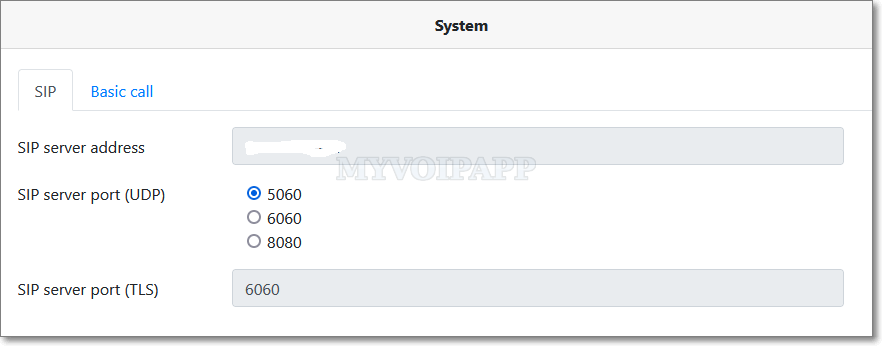
| Item | Description |
|---|---|
| SIP server address | The main address of the virtual SIP server. All SIP clients or devices should use this address to connect to (or call to) the virtual SIP server. This address is automatically assigned by the cloud system and cannot be edited. It is an independent domain name, but its IP address is shared with many virtual servers. |
| SIP server port (UDP) | UDP port for SIP communications. Each virtual server has an independent UDP port. The standard SIP port 5060 is also shared by all virtual servers, but it is better for the virtual server to use its own UDP port. |
| SIP server port (TLS) | The TLS port for SIP communications. The cloud system always opens the fixed port 6060 to receive or send SIP messages over TLS. All virtual servers can only use this TLS port. |
2.2 Basic call
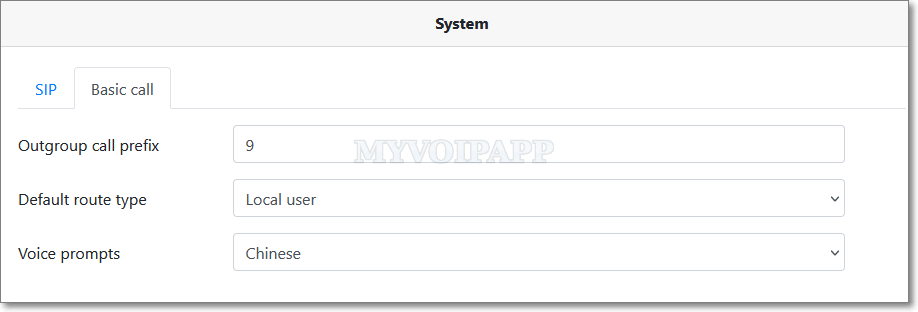
| Item | Description |
|---|---|
| Outgroup call prefix | Default prefix is '9'. When a local user makes an out group call to his/her carrier network, he/she shall dial this prefix before the real number. In the step by step document, there is a demo network and the local users need to add prefix '9' to make calls to outsides users. We can configure it to another character or just remove it. |
| Default route type |
miniSIPServer gets routing information according to the result of "dial plan" process. If this process is failed, miniSIPServer will use the default route type to continue the calls. It can be two kinds of types:
|
| Voice prompts | It is used to indicate miniSIPServer which language audio should be played. At this time, only english audios and Chinese audios can be provided. |
By default, miniSIPServer has pre-set three local users. Their names are '100', '101' and '102', and their passwords are '100', '101' and '102'. Of course, we can add, modify and delete local users dynamically and it is very easy to do that.
Please click 'Local user' button in main window toolbar or click menu 'Data / Local user' to show local users information windows.
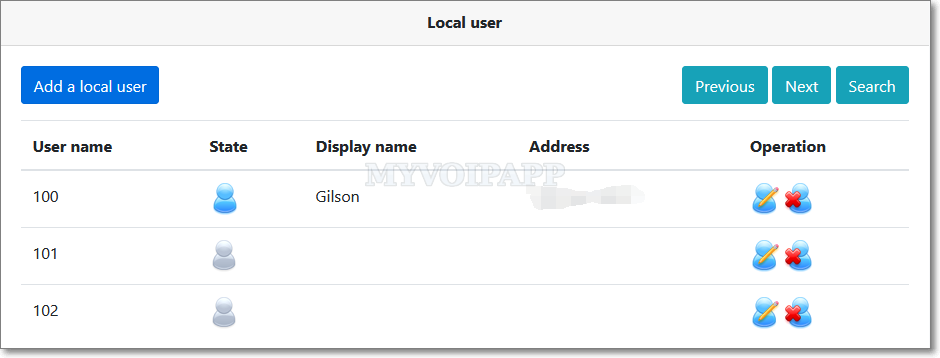
In this window, icons will be different according to local users' states.
| Icon | State |
|---|---|
 |
The user is off-line. |
 |
The user is online. |
 |
The user is ringing. |
 |
The user is talking. |
3.1 Basic

| Item | Type or value | Description |
|---|---|---|
| User name | String | Local user's name. |
| User password | String | User's password for SIP authorization. |
3.2 Basic call
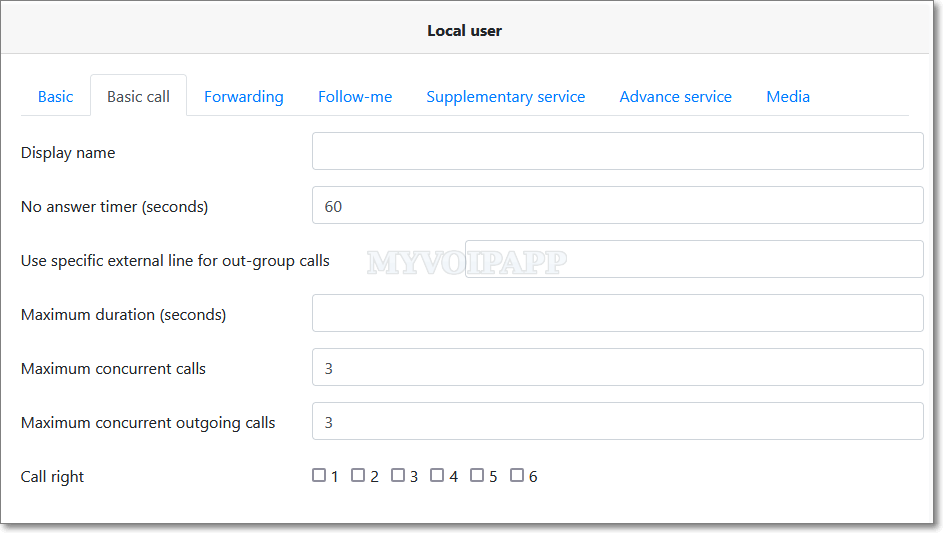
| Item | Type or value | Description |
|---|---|---|
| Display name | String | The caller name displayed to called party. For example, if the extension number is '100' and the 'display number' is 'Gilson', then called party will see 'Gilson' for its incoming calls; If this item is blank, the called party will see '100' for its incoming calls. |
| No answer time (seconds) | Integer | Indicate how long the call should be kept until the called party answers it. |
| Use specific external line for out-group call | String | If this item is configured, the local user will use this specific external line to make out-group calls. If it is blank, the locla user will use an available external line to make out-group calls. |
| Maximum duration (seconds) | Integer | It limits the maximum duration of outgoing call and miniSIPServer will release the call automaticlly if it reachs the max duration. |
| Maximum concurrent calls | Integer | It limits how many calls this local user can process at the same time. If it is zero, that means this user cannot make outgoing calls and cannot receive any incoming calls. |
| Maximum concurrent outgoing calls | Integer | It limits how many calls this local user can make at the same time. If it is zero, that means this user cannot make outgoing calls. |
| Call right | Integer | Call right for different calls. In "dial plan / analyze called number" table, some called number prefixs can be configured with different call right, only the users who have specific call right can make such calls. |
3.3 Forwarding
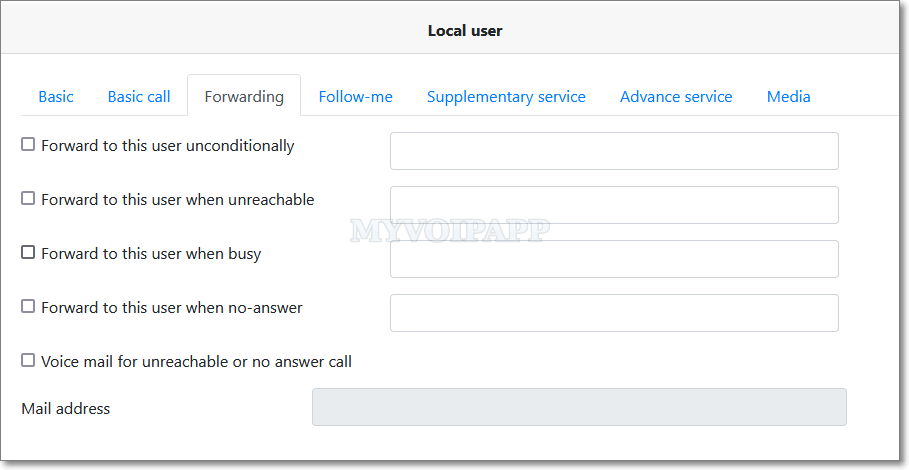
| Item | Type or value | Description |
|---|---|---|
| Forward call to this user unconditionally | Yes or no | "Forwarding service" right for local user. When it is selected, it means the user has this service right and a forwarding number can be configured together. Please refer to "call forwarding" service document for more details. |
| Forward call to this user when unreachable | Yes or no | |
| Forward to this user when busy | Yes or no | |
| Forward to this user when no-answer | Yes or no | |
| Voice mail for unreachable or no answer call | Yes or no | If the user is absent or doesn't answer the call, miniSIPServer will prompt the caller party to leave a message and send this voice message to the user's email box. |
| Mail address | email address | Local user's email address. miniSIPServer will send voice messages to this email address. Please refer to "voice mail" service document for more details. |
3.4 Follow me
Please refer to "Follow me service document" for more details.
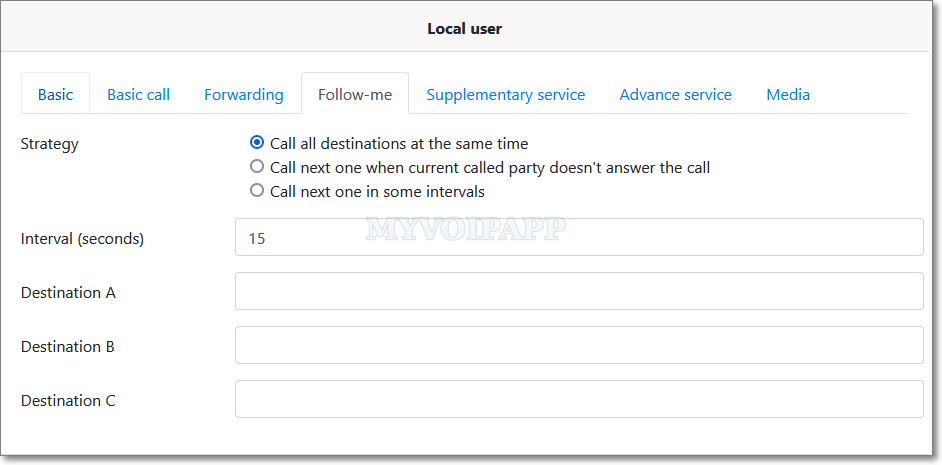
| Item | Type or value | Description |
|---|---|---|
| Strategy | 0, 1, 2 |
|
| Interval (seconds) | Integer | If the strategy is '2', this item must be configured. |
| Destination A | String | Destination A. |
| Destination B | String | Destination B. |
| Destination C | String | Destination C. |
3.5 Supplementary service
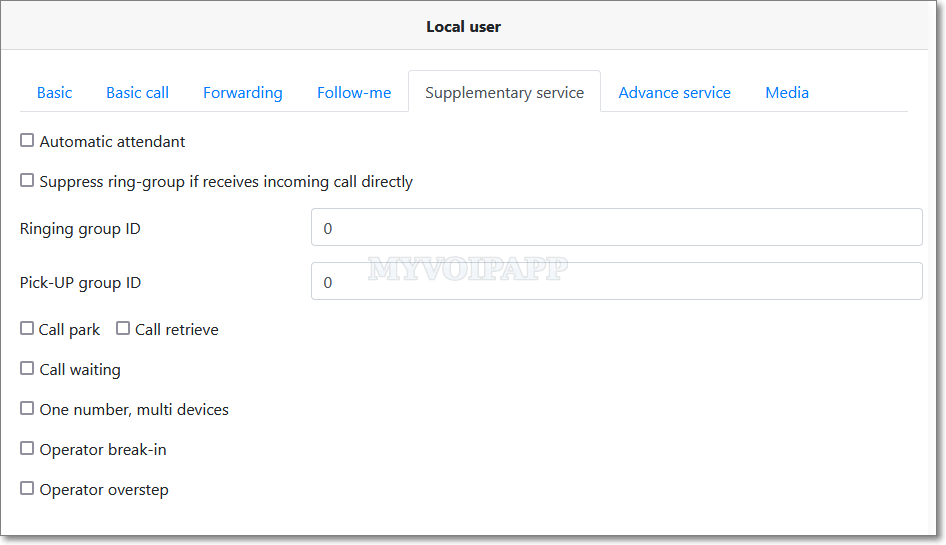
| Item | Type or value | Description |
|---|---|---|
| Automatic attendant | Yes or no | Current user is an automatic attendant or not. Please refer to "auto-attendant service document" for details about this service. |
| Suppress ring-group if receives incoming call directly | Yes or no | If this item is selected, this local user will ring and others in the same ring group will not ring together when caller party calls the user directly. |
| Ringing group ID | Integer, >=0 | If it is zero, the user is not configured with ringing-group feature. Otherwise, all users with the same ringing group ID are in the same ringing group. Please refer to "ringing group" document for more details. |
| Pick-UP group ID | Integer, >=0 | If it is zero, the user is not configured with pick-up feature. Othereise, all users with the same pick-up group ID are in the same pick-up group and can be picked up by the users in the same group. Please refer to "pick-up" service document for more details. |
| Call park | Yes or no | "Call park" service right indicator. Please refer to "Call park and call retrieve services" document for more details. |
| Call retrieve | Yes or no | "Call retrieve" service right indicator. Please refer to "Call park and call retrieve services" document for more details. |
| Call waiting | Yes or no | "Call waiting" service right indicator. Please refer to "Call waiting service" for more details. |
| One number, multi-devices | Yes or no | "One number, multi-devices" service right indicator. Please refer to "One number, multi-devices" for more details. |
| Operator break-in | Yes or no | "Operator" service right indicators. Please refer to "break-in and overstep service" for more details. |
| Operator overstep | Yes or no |
3.6 Advance service

| Item | Type or value | Description |
|---|---|---|
| Subscribe all users' presence or dialog information | Yes or no | Subscribe presence. If it is selected, miniSIPServer will report others users'status to this user. Please don't select this option for common users since there will have lots of SIP messages to be reported. |
| Presence group | Integer, >=0 | If this parameter is indicated, only the presence messages in the same group can be retrieved. |
3.7 Media

| Item | Type or value | Description |
|---|---|---|
| Music on hold | Yes or no | When SIP clients send HOLD message, miniSIPServer should play music to peer sides or not. |
| Relay media stream | Yes or no | Indicate miniSIPServer to relay media streams for SIP clients. If the SIP client is behind NAT and it cannot STUN, it needs miniSIPServer to help to relay media stream. If the SIP client can travel NAT itself, it is unnecessary to ask miniSIPServer to relay media stream. |
External lines are used to connect outside VoIP providers or VoIP gateways. Local users can call to or receive calls from outsides users.
Please click button 'External line' or click menu 'Data / External line' to get the main window of external lines.

In this window, icons will be different according to state of external lines.
| Icon | State |
|---|---|
 |
The external line hasn't registered to the carrier network or connected to a VoIP gateway. |
 |
The external line connects to the VoIP provider or VoIP gateway. It can receive calls from or send calls to outsides users now. |
4.1 Basic
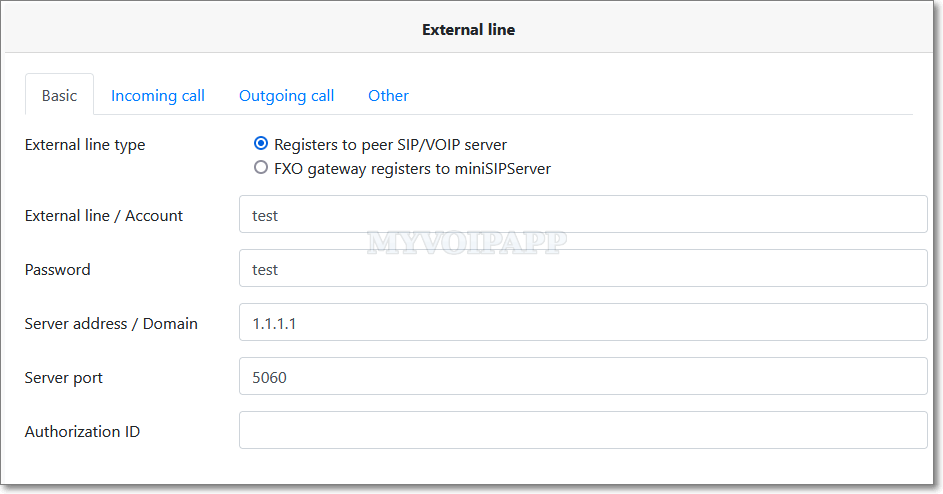
| Item | Type or value | Description |
|---|---|---|
| External line type | 0, 1 |
|
| External line / account | String | If external line type is 0, miniSIPServer will use this item as a user name to register itself to the VoIP provider. Otherwise, if the external line type is 1, the VoIP gateway will use this item as its user name to register itself to the miniSIPServer. |
| Password | String | Used in authorization to VoIP providers, or for FXO gateway. This item can be blank, it means unnecessary to authorize the account. |
| Server address / Domain | String | Peer SIP server address. It can be a IP address or a host name. If external line type is 1, this item is unusable and miniSIPServer will get VoIP gateway's real address according to its register messages. |
| Server port | Integer (>0) | Peer SIP server port to receive miniSIPServer's messages. If external line type is 1, this item is unusable and miniSIPServer will get VoIP gateway's real port according to its register messages. |
| Authorization ID | String | It is for authorization. it can be blank or same as external line account. If it is blank, miniSIPServer will use external line account for authorization. Some VoIP providers will require different authorization ID with its account, then this item should be configured. |
4.2 Incoming call

| Item | Type or value | Description |
|---|---|---|
| Transfer calls to |
|
If transfer incoming calls to auto-attendant, an auto-attendant service will be triggerred. If transfer incoming calls to a specific destination number, miniSIPServer will analyze this new number to get routing information. |
| Destination number | String | If transfer incoming calls to destination number, this item (1) can be configured with a new destination number, miniSIPServer will analyze the destination number to get the final routing information; or (2) can be blank, then miniSIPServer will analyze the original called number of incoming calls to get the routing information. |
4.3 Outgoing call
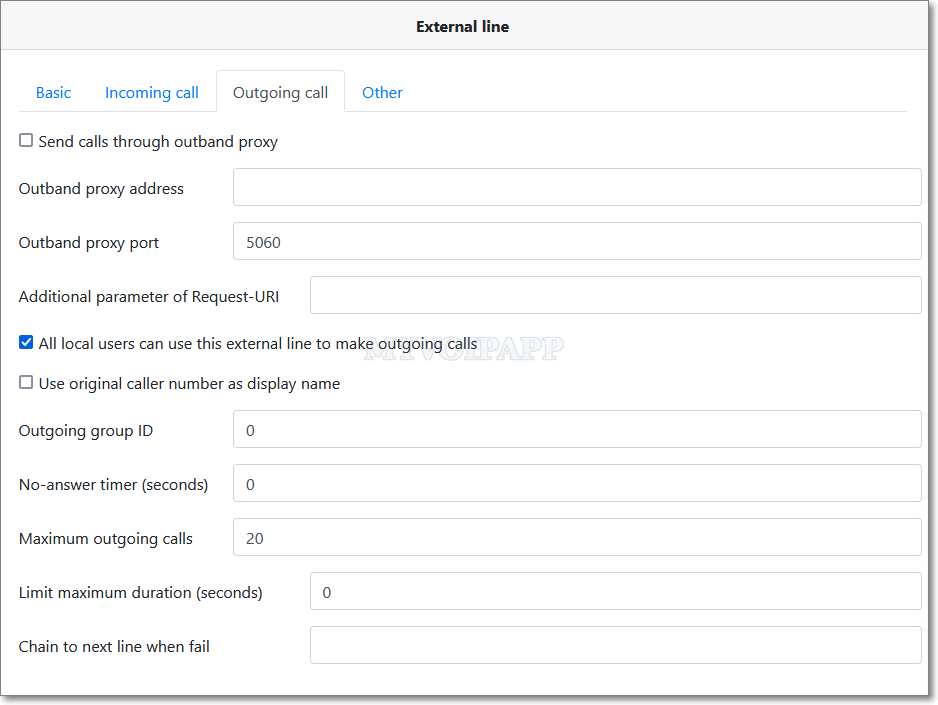
| Item | Type or value | Description |
|---|---|---|
| Send calls via outbound proxy | Yes or no | Some VOIP carriers require clients to send SIP messages to an outbound proxy server, then we need configure these outbound information to do that. |
| Outbound proxy address | String | IP address or host name of proxy server. |
| Outbound proxy port | Integer (>0) | Port of proxy server. |
| Additional parameter of Request-URI | String | This item can be blank. If it is configured, miniSIPServer will append it to the Request URI when sending out messages to VoIP providers' servers (or gateways). It depends on the requirements of VoIP providers. |
| All local users can use this external line to make outgoing calls | Yes or no | If it is yes, other local users of miniSIPServer can make out-group calls through this external line. If it is no, only the user binded to this external line can make calls to VOIP provider. In the incoming call configuration, the local user should be the destination number. |
| Use original caller number as display name | Yes or no | When make outgroup calls through current external line, miniSIPServer can transfer original caller number to peer side as "display name". Then, called party will see "original caller number" instead of "external line number". |
| Outgoing group ID | Integer (>=0) | Define a group ID for current external line. Sevaral external lines or SIP trunks can be configured with same group ID which will be used in "dial plan" process to change numbers. |
| No-answer timer (seconds) | Integer (>=0) | When outgoing call is through current line, this value will limit the no-answer timer value. If it is expired, the call will be released and next line will be tried. The default value is zero which means the call will use system default no-answer timer value. |
| Maximum outgoing calls | Integer (>=0) | Limit how many concurrent outgoing calls can be processed. If it is zero, that means the external line cannot process any outgoing call. |
| Limit maximum duration (seconds) | Integer (>=0) | It limits the maximum duration of outgoing call process. miniSIPServer will release the call automatically if the timer is expired. |
| Chain to next line when fail | String | If it is configured with another specific external line, when the call is failed, it will be routed to such line to try again. |
4.4 Other
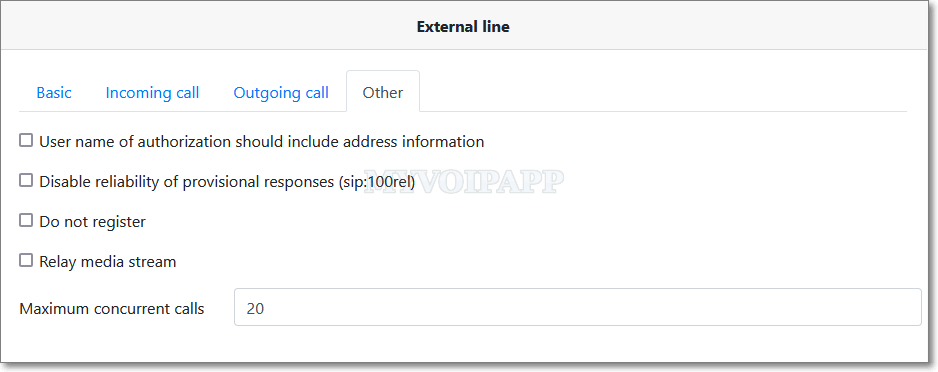
| Item | Type or value | Description |
|---|---|---|
| User name of authorization should include address information | yes or no | Some VoIP providers require that the user name of authorization MUST be 'user_name@domain' format, so enable this item will indicate miniSIPServer to use such format. Please pay attention that this item should be ignored if 'authorization ID' is configured in such format. |
| Disable reliability of provisional responses (sip:100rel) | yes or no | This is a special item. Some VoIP providers cannot support '100rel' capability and cannot rightly process INVITE messages with '100rel' indicator. So check this item to make miniSIPServer to remove '100rel' parameter from INVITE messages. |
| Do not register | yes or no | Some SIP trunk providers don't require REGISTER messages, then we can enable this item to work with them. |
| Relay media stream | yes or no | If this item is selected, miniSIPServer will have to relay media streams. |
| Maximum concurrent calls | Integer (>0) | The maximum concurrent calls current line is able to process. It includes incoming calls and outgoing calls together. |
Please refer to "SIP trunk document" for more details.
Please refer to "Routing group document" for more details.
"Dial plan" is the core fucntion of miniSIPServer, we seperate it to an independent document to describe its procedures and configuration. Please refer to "Dial plan document" for more details.
miniSIPServer can support lots of services, each service has its own document. Please refer to "Feature" page to get all services' documents.
Please refer to "Call details record (CDR)" for more details.